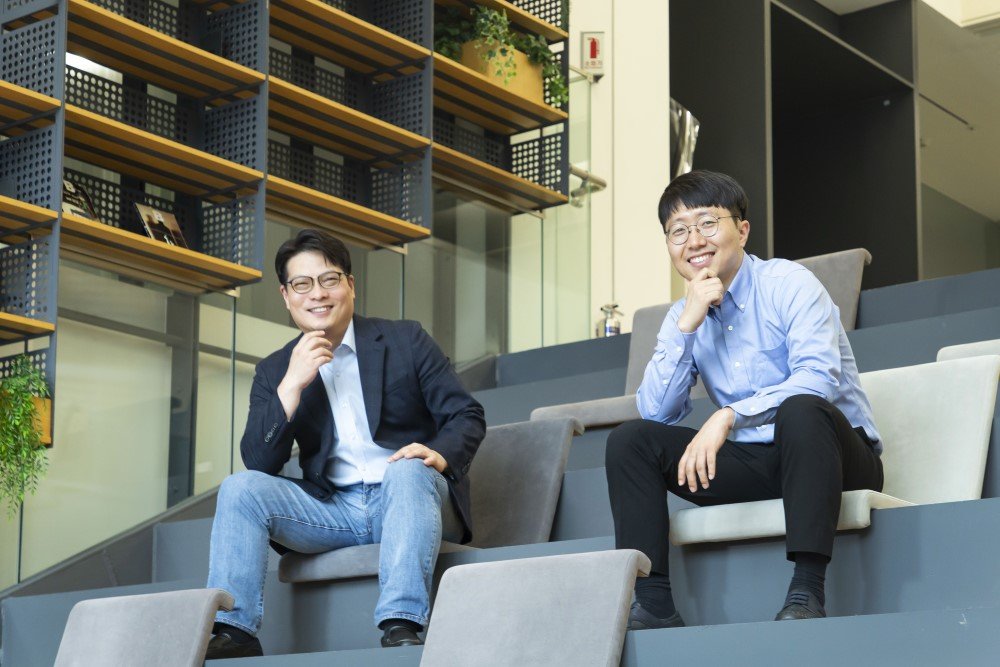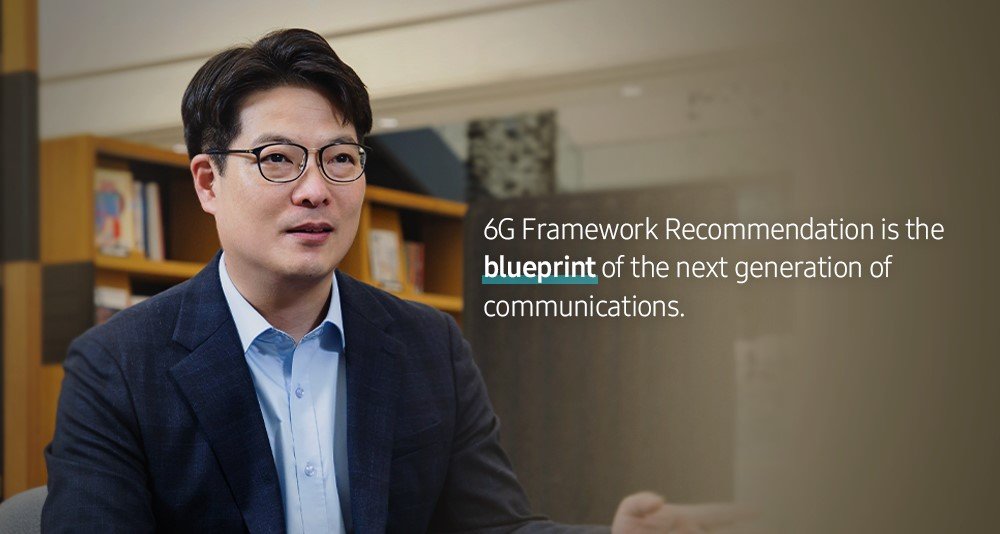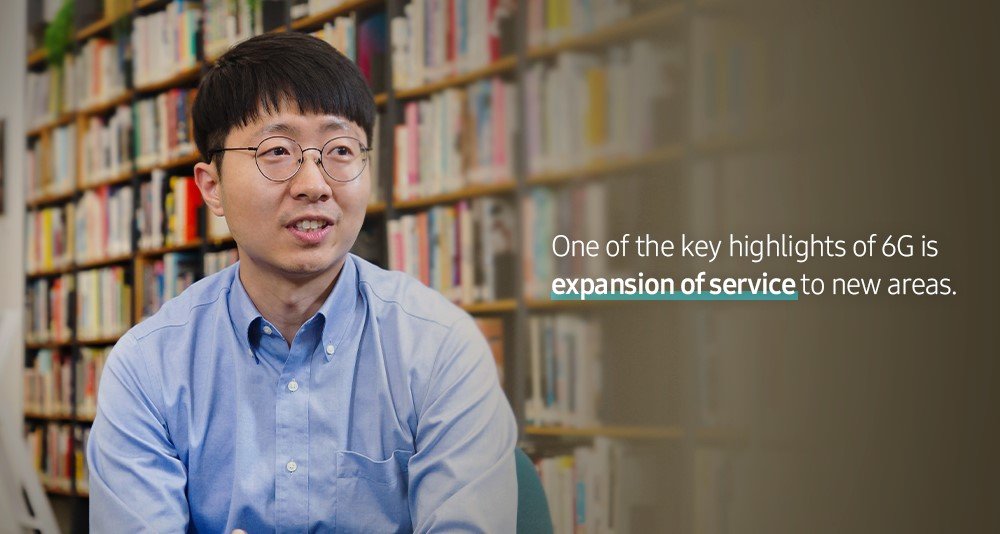When we travel abroad, we can freely use our smartphones in different countries and regions through connected roaming services. This is because most countries follow the same standards — an agreed-upon promise — for communication technologies. If these telecommunications standards were any different, we wouldn’t be able to use our smartphones as easily and conveniently in different countries as we are able to today.
6G, the next generation of communication technology, just took its most important first step. Discussions on the global standards for 6G have been ongoing since early 2021. Presenting a standard for 6G technology, the Draft IMT-2030 (hereinafter 6G) Framework Recommendation was developed by the International Telecommunication Union — Radiocommunication Sector (ITU-R)1 in June 2023. This milestone marks the completion of the first stage towards opening a new era of communication.

▲ (From left) Samsung Research’s HyoungJin Choi and Hyunjoong Lee participated in the development of the Draft 6G Framework Recommendation.
In July 2020, Samsung Electronics released a 6G white paper entitled “The Next Hyper-Connected Experience for All,” presenting various aspects related to 6G — including technical and societal megatrends, new services, requirements, candidate technologies and an expected timeline for standardization. As a result of the white paper’s worldwide recognition, Samsung’s researchers are now leading efforts to standardize the next-generation communication technologies. Samsung Newsroom sat down with HyoungJin Choi, Chair of ITU-R’s 6G Vision Group, from Samsung Research’s Advanced Communications Research Center (ACRC) Communications Standards Research Team, and Hyunjoong Lee from Samsung Research’s ACRC 6G Research Team who both participated in the development of the Draft 6G Framework Recommendation.
Finalization of the Draft 6G Framework Recommendation, the Blueprint of a New Communication Technology
The Draft 6G Framework Recommendation covers key information regarding the usage scenarios that 6G would pursue as well as capabilities and roadmaps toward the international standardization and commercialization of 6G.

As chair of ITU-R’s 6G Vision Group, HyoungJin Choi led the development of the Draft 6G Framework Recommendation. He described it as “the blueprint of a new communication technology,” and stressed its importance by saying: “Once it is completed, the detailed standardization activities from the definition of technical performance requirements to the finalization of technical specifications for radio interface technologies can be carried out.”

To construct a building, various decision-making processes from site development to construction methods are required. The process of developing new communication technologies is similar to this. Assuming that technology commercialization is a building, it is necessary to create a blueprint so that all construction procedures follow the same rules and norms. In our case of 6G technology, the blueprint is the Framework Recommendation. Additionally, it is necessary to determine the location and area of the land for building – in our example, this would be the frequency band. Therefore, it is essential to define a Framework Recommendation as a blueprint to build next-generation mobile telecommunication.
“From now on, standards development organizations — including the 3rd Generation Partnership Project (3GPP) — will be developing technologies that satisfy the vision suggested by the 6G Framework, which will be submitted to ITU-R as candidate technologies,” said Choi. “Next, ITU-R will evaluate them and determine which one will be adopted as the 6G standard. When it comes to setting 6G capabilities or deciding the frequency bands needed for this communication technology, participating countries need to go through intense agreement processes.”
Expanding 6G Vision Beyond Its Limits
The question that remains for 6G is: How will this new communication technology be different?

“In the 6G era, the goal will be to provide diverse and expanded services in new areas such as ‘Integrated AI and Communication,’ ‘Integrated Sensing and Communication’ and ‘Ubiquitous Connectivity,’” said Hyunjoong Lee, a Samsung Research ACRC 6G Research Team member who actively participated in the development of the Draft 6G Framework Recommendation.

▲ Usage scenarios and overarching aspects of 6G (left) and capabilities of 6G (right) as outlined in the Draft 6G Framework Recommendation, proposing extended usage scenarios and improved technology capabilities compared to 5G.2

“In the 6G era, communication technologies are expected to enhance human experiences by seamlessly connecting the real world and the digital world,” said Lee. Thanks to digital twin and immersive communication technologies such as “XR” and “Holograms,” it is envisaged to provide various services such as educational and medical services to underdeveloped areas.
Working Through Differences: Developing a Framework for Everyone
Since the role and importance of communications have increased, setting the standard early on has become just as important as developing the technology itself. The completion of the Draft 6G Framework Recommendation is a valuable outcome of more than two and half years of countless discussions, compromises and agreements among the 193 member states and more than 900 member companies.
Choi played a leading role in setting the overall direction of the Recommendation’s development since he was appointed chair after building trust within the ITU-R over several years. Lee played the role of introducing and reflecting technical aspects into the Draft 6G Framework Recommendation. Although Choi and Lee played different roles in ITU-R, they moved as one to achieve a common goal. While they faced many challenges during the process, they achieved successful results thanks to their dedicated cooperation and great teamwork.

▲ HyoungJin Choi at the moment when the agreement was reached regarding the Draft 6G Framework Recommendation.
The past two years have not been easy for Choi, who had to balance various perspectives from its members as chair. “It was very difficult resolving the differences among the members,” he said. Choi had spent half the time worrying that there would continue to be unexpected issues right down until the very last minute. “Although it was a difficult process, it was very rewarding when the final agreement was reached among the members after everyone worked hard with the same determination and goal in mind.”
“As we headed to Switzerland, where the final meeting was held, we still felt worried,” noted Lee. “Fortunately, the main issues had been resolved well, and we were able to return home with a sense of relief and happiness.”


Turning the Dream of the 6G Era Into Reality
Samsung Research has been conducting extensive studies to lead 6G innovation. “We’ve been achieving meaningful results in our 6G technological development research using AI and Sensing technology recently,” said Lee. “We’ve conducted research on efficiently utilizing communication resources with AI. This can increase the communication speed experienced by users while significantly reducing the energy needed for transmitting the same amount of information, which ultimately provides more sustainable communication experiences.” When it comes to “Integrated Sensing and Communication” technologies, Lee explained: “We’re pursuing research and development on how to integrate communication technologies into daily use cases such as location tracking or the speed estimation of an object.”
Choi and Lee shared their plans and aspirations for the next generation of communications going forward. Both researchers hope for a future in which next-generation communication technology can become an established technology that enriches all of our lives.
“We will work hard to enable more abundant communication that transcends previous limitations through all kinds of connection types — including between people and people, people and machine, and even machine and machine,” said Choi. “We will do our best to achieve meaningful results in standardizing the spectrum and 6G requirements that can be carried out in the future.”
“I will continue to work so that 6G communication technology can be more impactful and relevant to people’s lives by providing more immersive experiences,” said Lee, regarding his own aspirations for the rest of his 6G journey. “While making the Framework Recommendation, my twin daughters were born, and I am proud to think that we are making the technology that they will use in the future.”

▲ (From left) HyoungJin Choi and Hyunjoong Lee making a “6G” sign with their hands.
Both Choi and Lee consider the completion of the Draft 6G Framework Recommendation as a new starting point for 6G technology. As Samsung and Samsung Research’s experts continue to usher the next era of communication technology, the reality of 6G commercialization draws closer every day.
1 As the radiocommunication sector within the United Nations’ specialized agency for information and communication technologies agency, the International Telecommunication Union — Radiocommunication Sector oversees the standardization of radiocommunication technology and spectrum. It sets the standard for international mobile telecommunications (IMT) wireless communication technology and provides to its member states.
2 For more information, please refer to Samsung Research’s “All set for 6G!”
This article was first published at Source link . You can check them out for other stuffs
